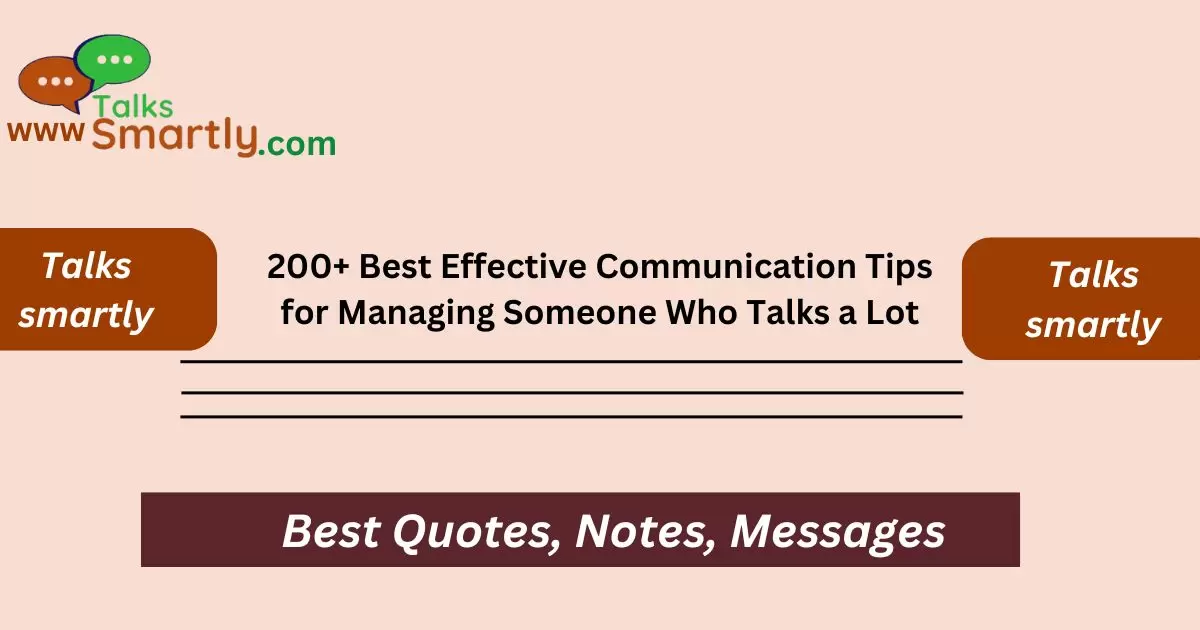Managing someone who talks a lot can be challenging. Here are 200+ communication tips to help you handle conversations effectively.
Communication is key in any relationship, but when someone talks too much, it can become overwhelming. Knowing how to manage these situations with grace and clarity can make a big difference in your interactions.
In this article, you’ll discover practical tips to handle conversations with people who tend to dominate the discussion. Whether in a personal or professional setting, these strategies will help you maintain control without offending the other person.
These tips are designed to be easy to implement and effective. By applying them, you’ll foster more balanced and meaningful conversations, ensuring that everyone’s voice is heard.
Setting Boundaries Politely
- Politely interrupt to share your thoughts.
- Use body language to signal your turn to speak.
- Set time limits for discussions.
- Acknowledge their points and then shift focus.
- Gently steer the conversation back on track.
- Use humor to lighten the mood and change the subject.
- Suggest a break to refocus the conversation.
- Use phrases like “Let’s hear from others too.”
- Summarize their points to transition.
- Agree and redirect to another topic.
- Use “I” statements to express your needs.
- Be firm yet polite in your responses.
- Practice active listening to show respect before speaking.
- Politely decline to engage in certain topics.
- Set clear expectations for conversation flow.
- Use direct communication when necessary.
- Encourage mutual respect in the conversation.
Keeping the Conversation Balanced
- Invite others to share their thoughts.
- Ask open-ended questions to involve everyone.
- Encourage turn-taking in group settings.
- Reflect on the conversation to highlight key points.
- Acknowledge contributions from all participants.
- Use inclusive language to bring everyone in.
- Keep the topic broad to allow multiple inputs.
- Politely steer away from one-sided discussions.
- Praise conciseness when others share.
- Stay focused on the topic to avoid rambling.
- Use “we” instead of “I” to promote group discussion.
- Model good conversation habits by being concise.
- Encourage shy participants to speak up.
- Gently remind the speaker to give others a chance.
- Create a comfortable space for everyone to contribute.
- Use time cues to keep the discussion on track.
- Highlight the value of diverse opinions.
Redirecting the Conversation
- Gently change the topic when needed.
- Acknowledge the speaker before redirecting.
- Use transitions like “That reminds me of…”
- Ask a question to shift focus.
- Share a related story to change the subject.
- Summarize the main points and move on.
- Politely ask to discuss another topic.
- Mention time constraints to change gears.
- Use humor to redirect the conversation.
- Reference previous points to transition.
- Use direct language when needed.
- Suggest a new topic that interests everyone.

- Highlight the importance of discussing other matters.
- Ask for others’ opinions on a new topic.
- Use phrases like “We’ve covered that well, let’s move on.”
- Tie the conversation to a current goal or task.
- Use reflective listening to acknowledge and shift.
Staying Calm and Composed
- Take deep breaths before responding.
- Maintain eye contact to show confidence.
- Stay patient even when frustrated.
- Use a calm tone to avoid escalating the situation.
- Practice mindfulness to stay focused.
- Avoid interrupting unless necessary.
- Use pauses to gather your thoughts.
- Remain neutral and avoid getting emotional.
- Acknowledge your feelings but stay composed.
- Focus on solutions, not problems.
- Use positive affirmations to keep calm.
- Stay present in the conversation.
- Remember your goal in the discussion.
- Use self-control to avoid overreacting.
- Choose your words carefully to maintain composure.
- Stay open-minded even if you disagree.
- End the conversation if you feel overwhelmed.
Encouraging Active Listening
- Model active listening by nodding and summarizing.
- Ask clarifying questions to show interest.
- Give full attention to the speaker.
- Avoid distractions like phones or multitasking.
- Use encouraging words like “I see” or “Go on.”
- Reflect on what you’ve heard before responding.
- Avoid interrupting to show respect.
- Repeat key points to confirm understanding.
- Show empathy by acknowledging feelings.
- Use eye contact to stay engaged.
- Encourage the speaker to continue.
- Summarize the conversation to ensure clarity.
- Validate their points even if you disagree.
- Avoid judging while listening.
- Focus on the message, not just the words.
- Ask follow-up questions to dive deeper.
- Appreciate the speaker’s efforts to communicate.
Managing Group Conversations
- Establish ground rules for speaking times.
- Encourage equal participation from everyone.
- Use a talking stick or token to control turns.
- Set clear objectives for the meeting.
- Encourage conciseness in contributions.
- Summarize discussions to keep track.
- Redirect off-topic comments back to the agenda.
- Encourage collaboration and teamwork.
- Acknowledge each person’s input to build morale.
- Set time limits for each topic.
- Facilitate quiet members to speak up.
- Keep the conversation focused on the agenda.
- Use visual aids to keep discussions on track.
- Encourage open-mindedness and respect.
- End on a positive note by summarizing achievements.
- Encourage action points to move forward.
- Evaluate the effectiveness of the meeting.
Using Nonverbal Communication
- Maintain eye contact to show engagement.
- Use gestures to emphasize points.
- Smile to create a friendly atmosphere.
- Use nodding to show agreement.
- Keep an open posture to invite conversation.
- Avoid crossing arms to seem approachable.
- Mirror the speaker’s body language to build rapport.
- Use facial expressions to convey emotions.
- Lean in slightly to show interest.
- Use pauses to control the conversation flow.
- Maintain an appropriate distance to respect space.
- Use hand gestures to clarify points.
- Be mindful of your tone to match your words.
- Use silence as a powerful tool to make a point.
- Show empathy through your expressions.
- Use subtle cues like raising eyebrows to indicate listening.
- Practice confident posture to convey authority.
Avoiding Miscommunication
- Clarify your intentions before speaking.
- Use simple language to avoid confusion.
- Ask for feedback to ensure understanding.
- Summarize key points to confirm clarity.
- Avoid jargon that others may not understand.
- Use examples to illustrate your points.
- Be specific with your instructions.
- Double-check understanding by asking questions.
- Avoid assumptions about what others know.
- Confirm details like dates and times.
- Use written communication to reinforce messages.
- Avoid ambiguous language that can be misinterpreted.
- Check in regularly to ensure everyone is on the same page.
- Use repetition for important points.
- Clarify complex ideas with visual aids.
- Encourage open dialogue to clear up misunderstandings.
- Be patient when explaining difficult concepts.
Handling Interruptions
- Politely ask to finish your point before responding.
- Acknowledge the interruption but continue speaking.
- Use a hand gesture to signal you’re not done.
- Stay calm and composed when interrupted.
- Address the interrupter directly if needed.
- Remind them politely of the conversation rules.
- Use humor to defuse tension from interruptions.
- Summarize your point to regain control.
- Redirect the conversation back to your topic.
- Set clear expectations for when others can speak.
- Use pauses strategically to avoid interruptions.
- Acknowledge the interrupter’s point and then continue.
- Reinforce the importance of taking turns.
- Ask for their input after finishing your point.
- Politely decline to engage in interruptions.
- Stay focused on your message, not the interruption.
- End with a strong statement to keep attention.
Being Assertive
- Use “I” statements to express your needs.
- Be direct but polite in your communication.
- Stand firm in your boundaries.
- Use clear and concise language to avoid misunderstandings.
- Practice saying “no” without guilt.
- Acknowledge the other person’s feelings while staying firm.
- Maintain eye contact to show confidence.
- Use a firm tone to assert your point.
- Set clear expectations for communication.
- Be respectful but unwavering in your stance.
- Avoid passive-aggressive behavior by being straightforward.
- Use assertive body language to reinforce your words.
- Practice active listening to show respect while being assertive.

- Acknowledge the other person’s point before stating yours.
- Use assertive statements like “I need,” “I want.”
- Avoid apologizing unnecessarily when being assertive.
- Reinforce your point with facts or examples.
Managing Expectations
- Set clear goals for the conversation.
- Discuss expectations openly and honestly.
- Clarify your role in the discussion.
- Align expectations with reality.
- Use specific language to avoid misunderstandings.
- Reiterate key points to ensure understanding.
- Ask for feedback on expectations.
- Set time frames for discussions.
- Encourage mutual agreement on expectations.
- Be realistic in what you expect from others.
- Avoid setting expectations that are too high.
- Use written communication to reinforce expectations.
- Check in regularly to ensure expectations are met.
- Adjust expectations based on the conversation’s flow.
- Be flexible but firm in your expectations.
- Use positive reinforcement when expectations are met.
- Evaluate and revise expectations as needed.
Mastering Conversations: 250+ Top Strategies for Effectively Managing Chatty Team Members
Ending Conversations Gracefully
- Summarize the key points before ending.
- Thank the person for the conversation.
- Use closing statements like “Let’s continue this later.”
- Acknowledge any unresolved issues for future discussion.
- Set a follow-up time if needed.
- Use body language to signal the end of the conversation.
- Politely excuse yourself from the discussion.
- Be direct if you need to leave.
- Wrap up the conversation with a positive note.
- Offer to continue the conversation at another time.
- Acknowledge the other person’s contributions before ending.
- Reiterate any action points before leaving.
- Express appreciation for the discussion.
- End with a compliment if appropriate.
- Use phrases like “I think we’ve covered everything.”
- Close with a strong statement to leave a lasting impression.
- Exit gracefully without rushing.
Answer to key question
1. How can I politely interrupt someone who talks a lot? You can say, “I’d love to share my thoughts too” or “Can I add something here?”
2. What if someone doesn’t get the hint and keeps talking? Gently but firmly state, “I’d appreciate a chance to speak now.”
3. How do I manage group conversations with a dominant speaker? Encourage turn-taking by saying, “Let’s hear from everyone on this.”
4. How can I stay calm when I feel overwhelmed? Take deep breaths and focus on your goal in the conversation.
5. What’s the best way to end a conversation gracefully? Summarize key points and thank the person for their time.
Conclusion
Managing conversations with someone who talks a lot can be challenging, but with the right techniques, you can maintain control and keep the dialogue productive. These tips will help you stay calm, assertive, and balanced, ensuring that everyone has a chance to speak.
By applying these strategies, you’ll create more meaningful interactions, where all voices are heard, and conversations are enjoyable and effective for everyone involved.












